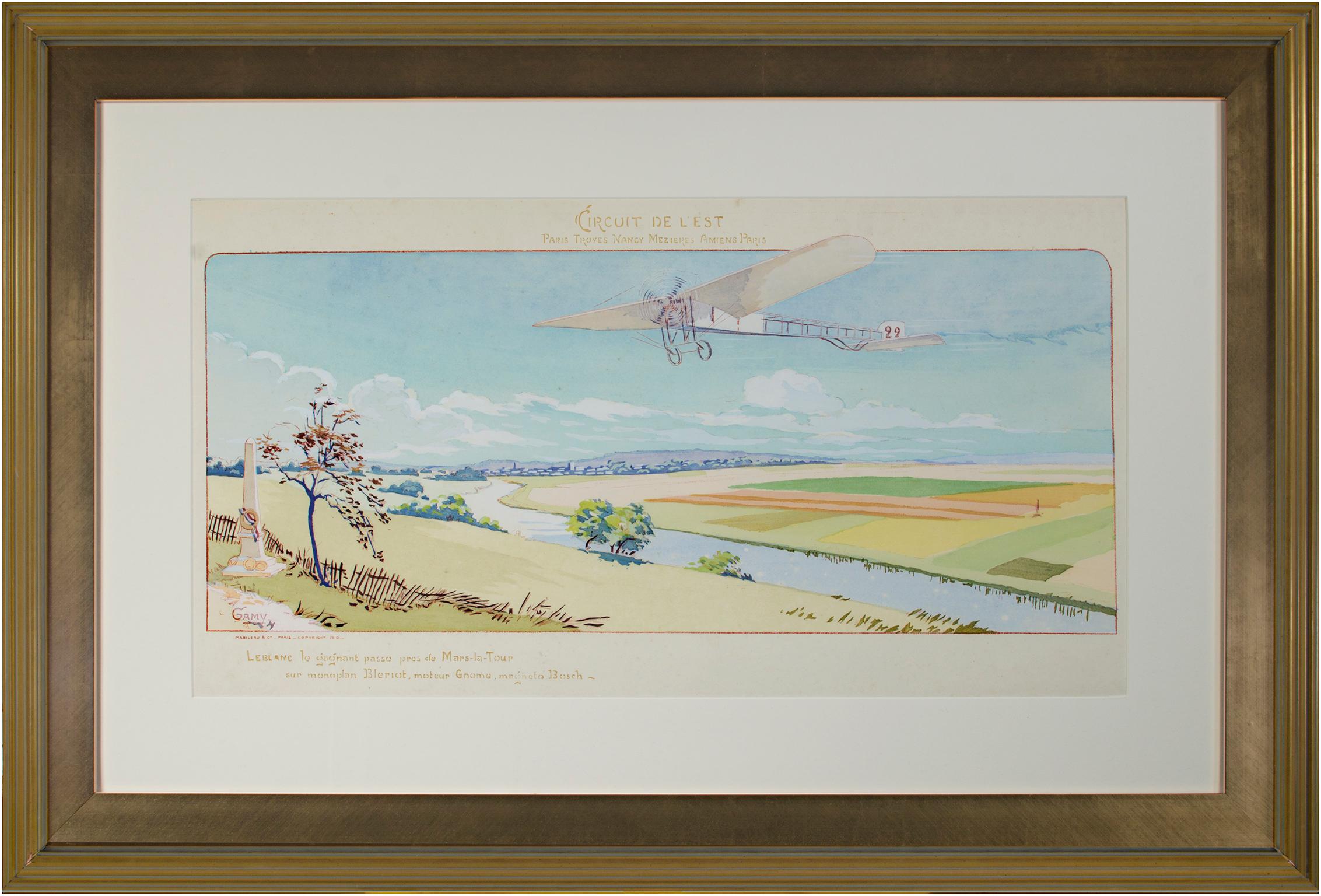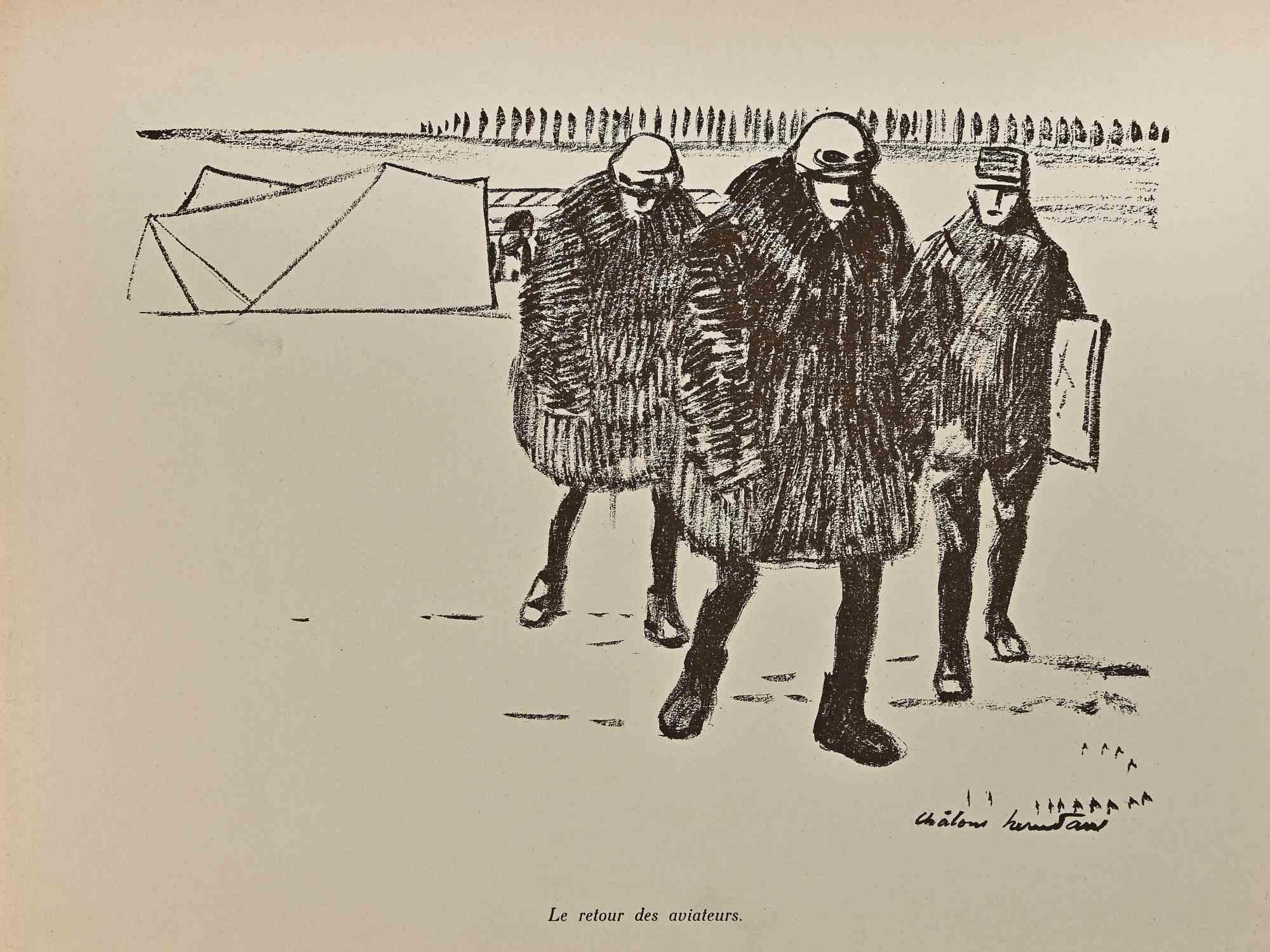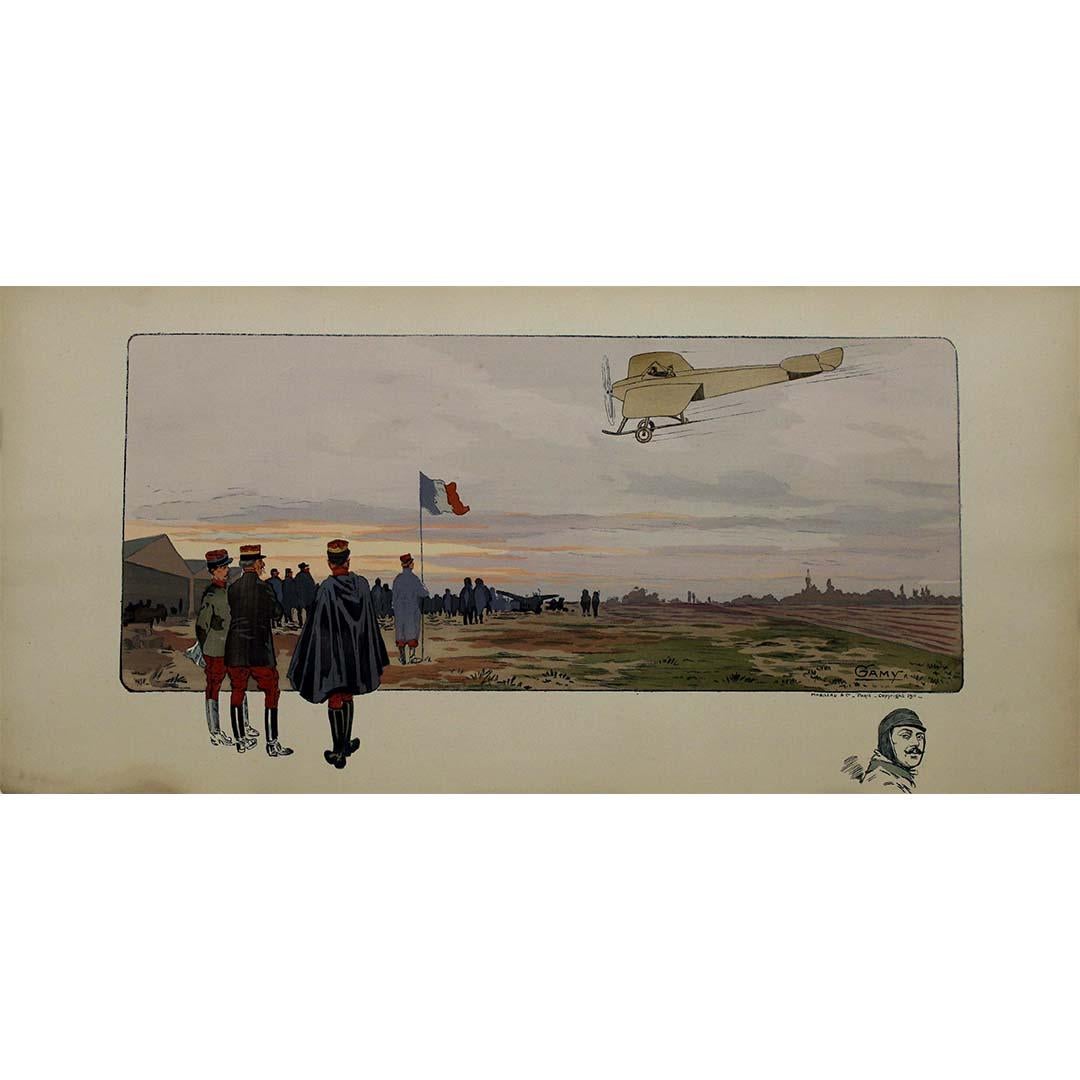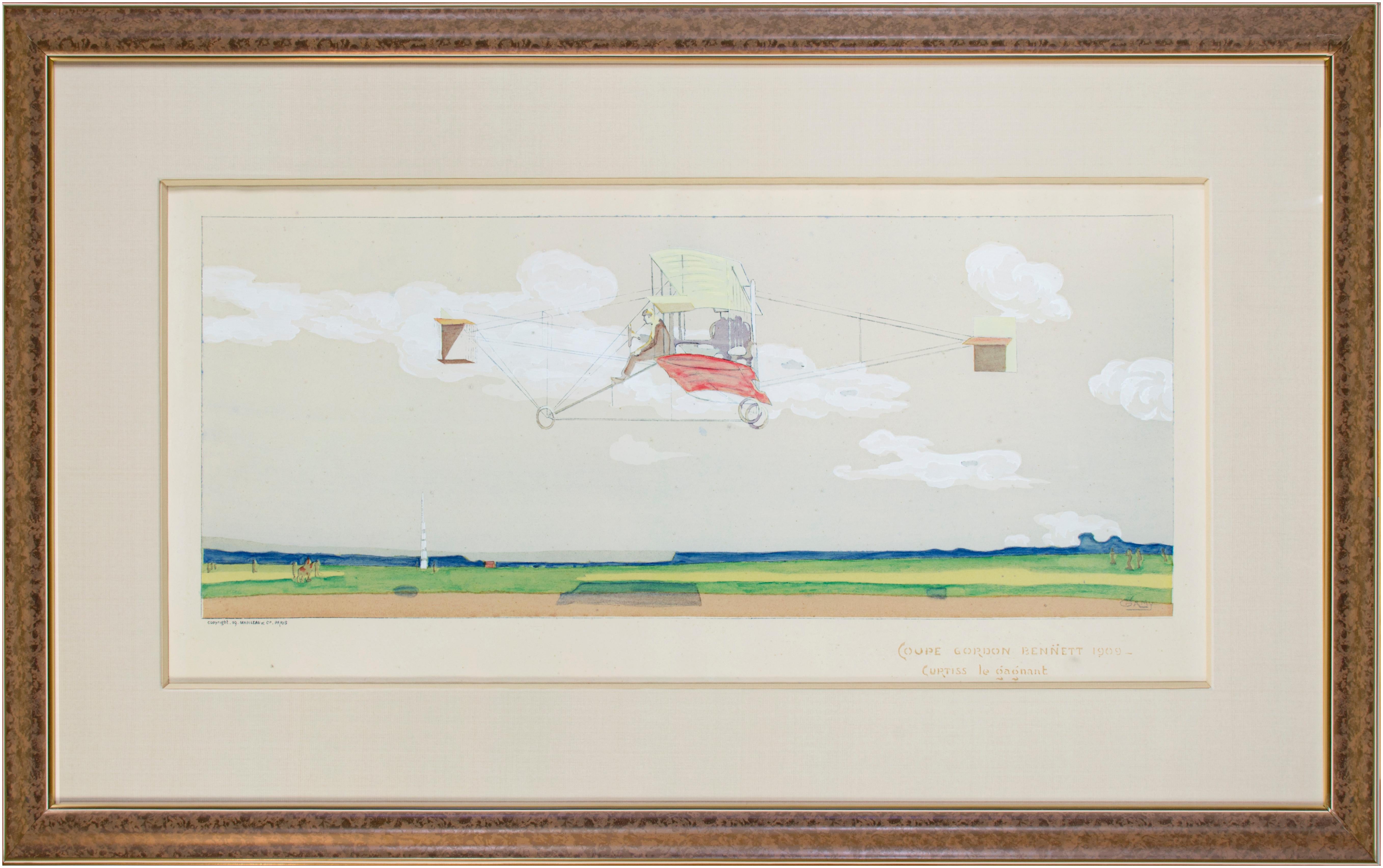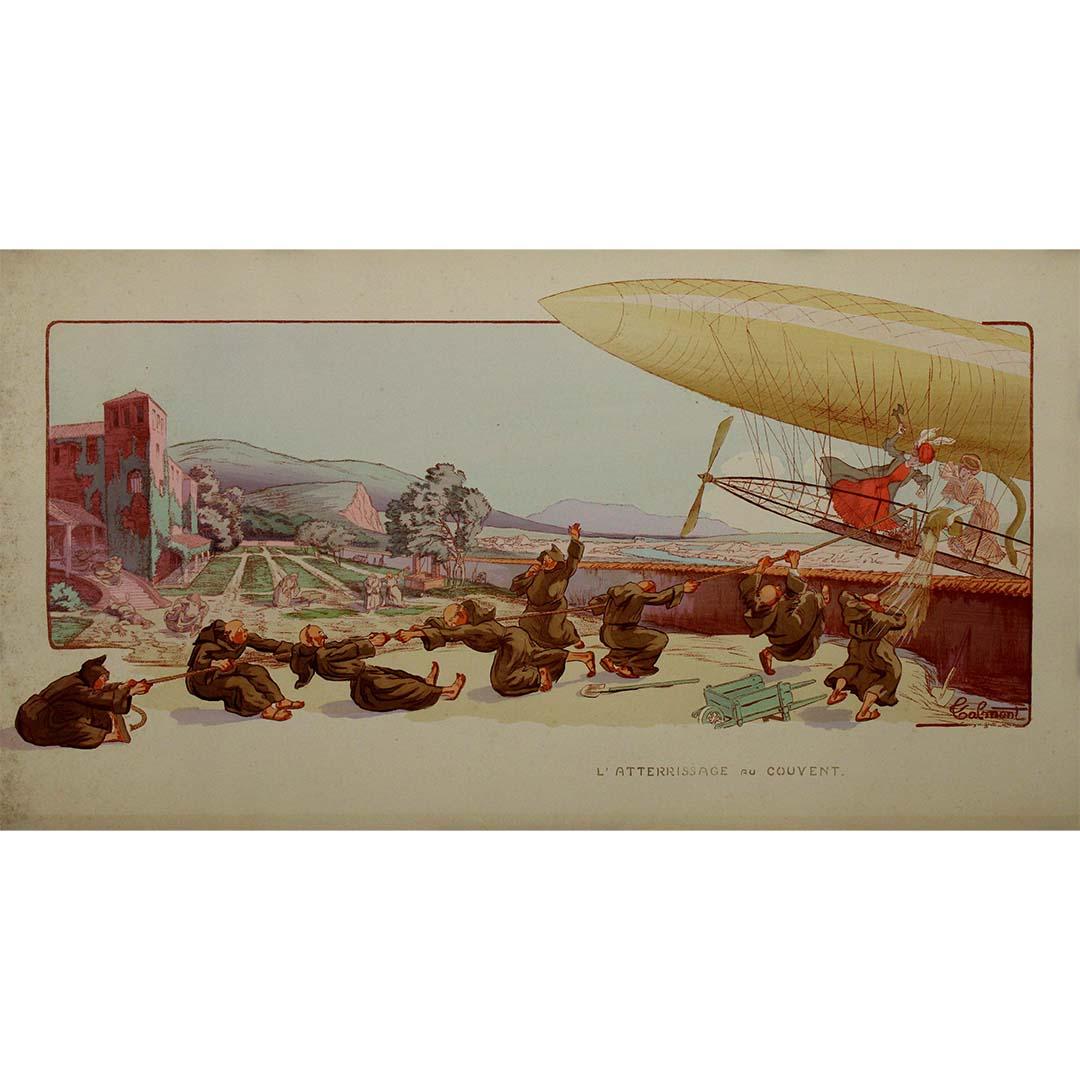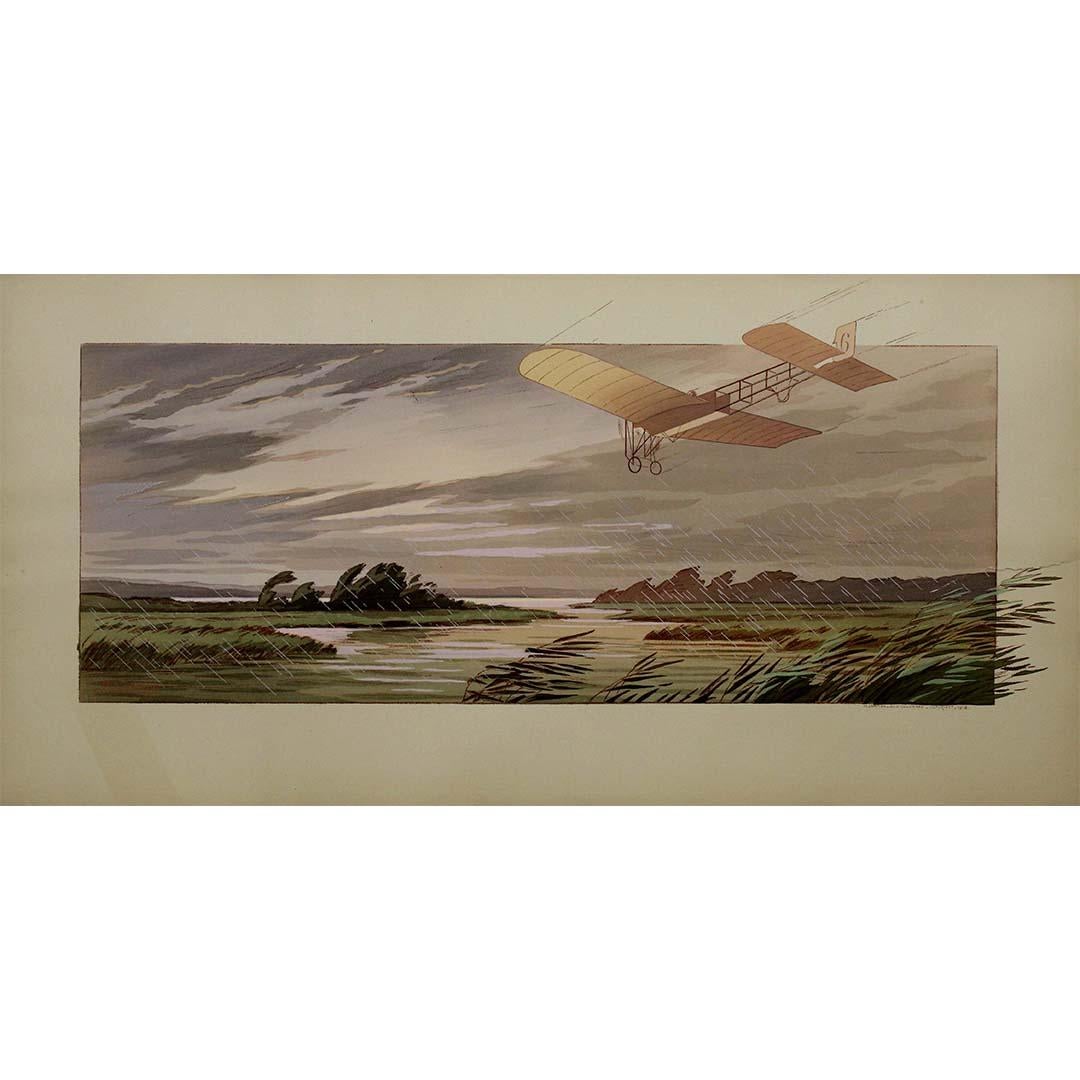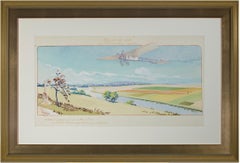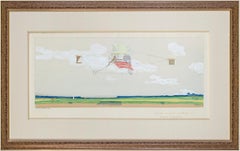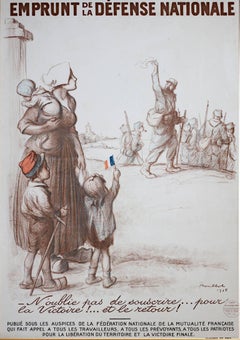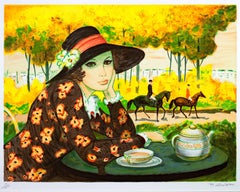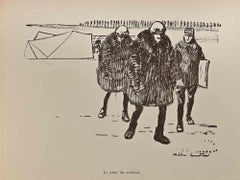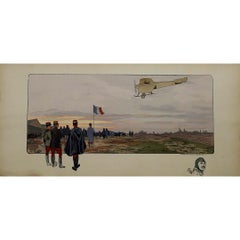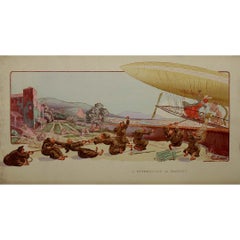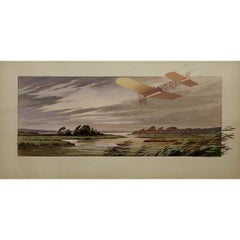Items Similar to "French Air Show with Remarque of Head of Pilot, " Lithograph & Stencil by GAMY
Want more images or videos?
Request additional images or videos from the seller
1 of 8
Marguerite Montaut"French Air Show with Remarque of Head of Pilot, " Lithograph & Stencil by GAMY1911
1911
$5,750
£4,425.53
€5,039.89
CA$8,174.47
A$8,885.93
CHF 4,657.01
MX$108,149.30
NOK 58,620.62
SEK 55,084.30
DKK 37,637.96
About the Item
"French Air Show with Remarque of Head of Pilot" is an original lithograph and stencil print by Marguerite Montaut (GAMY). It depicts an early airplane flying above a crowd of spectators. The pilot is depicted in the lower right, below the artist's signature (in stone).
Artwork Size: 14 5/8" x 27 1/4"
Frame Size: 26 1/4" x 41 5/8"
Artist Bio:
Gamy is the name used by the prolific printmaker Marguerite Montaut, specializing in images of aviation & racing. She was a turn-of-the-century artist, wife of Ernest Montaut, and is credited with inventing many artistic techniques, including speed lines and the deliberate distortion of perspective by bending and foreshortening the image in order to create the illusion of movement and speed. Many of these techniques have stood the test of time and are still used today by artists that draw and paint transportation subjects.
She produced her own works and a with her husband, also a printmaker, under the combined name of Gamy-Montaut. Ernest Montaut (1879-1909) and his wife, Marguerite (who Gamy is possibly a pseudonym for), were the first artists to capture the Heroic Age of aviation and motor racing. The Gamy-Montaut prints were produced by the pochoir process, in which the outlines for each image were drawn onto lithographic stones, printed and hand-coloured.
Marguerite Montaut, Ernest's wife, joined him in his work producing not only racing prints but also developing a fine series of aviation prints commemorating such events as the first flights on the early European mail routes. While Marguerite Montaut's works were occasionally signed "M. Montaut", she also used the name "Gamy", an anagram for Magy.
The Gamy-Montaut prints document various historical events in the early history of motorized transportation, including Power Boat Racing, Motorcycle and Motor Car Racing, Motor Car Touring, Zeppelins and Airplanes. Having observed the rapidly growing interest in cars and racing during the early years of motor cars, Ernest Montaut produced his first motoring prints in the mid-1890s, and by 1897, his drawings were pictorial records of the many races in France. Montaut's work was extremely well received in the Paris of his day and was shown in the fashionable shops of the Rue de l'Opera and Rue de la Paix, as well as in the better galleries. The Gamy-Montaut prints were all produced by the pochoir process in which the outlines for each image were drawn onto lithographic stones and printed. Using these uncoloured prints as a template, elaborate stencils were cut for each colour. Water-colour was then brushed onto the image through the stencil. The colouring process was quite complex, with each print taking several days to produce. It was also quite labour intensive, and the studio of Gamy-Montaut therefore employed a group of trained artists, including Nevil and Campion, to assist in the colouring. Besides his wife, other artists known to have worked for or with Montaut include Roowy, Nevil, Campion, Aldelmo, Brie, Dufourt and Jobbe du Val and we are sure that there are others!
- Creator:Marguerite Montaut (French)
- Creation Year:1911
- Dimensions:Height: 26.25 in (66.68 cm)Width: 41.625 in (105.73 cm)
- Medium:
- Movement & Style:
- Period:
- Framing:Frame IncludedFraming Options Available
- Condition:
- Gallery Location:Milwaukee, WI
- Reference Number:Seller: 10696g1stDibs: LU60533411371
About the Seller
4.9
Gold Seller
Premium sellers maintaining a 4.3+ rating and 24-hour response times
Established in 1966
1stDibs seller since 2017
451 sales on 1stDibs
Typical response time: 2 hours
- ShippingRetrieving quote...Shipping from: Milwaukee, WI
- Return Policy
Authenticity Guarantee
In the unlikely event there’s an issue with an item’s authenticity, contact us within 1 year for a full refund. DetailsMoney-Back Guarantee
If your item is not as described, is damaged in transit, or does not arrive, contact us within 7 days for a full refund. Details24-Hour Cancellation
You have a 24-hour grace period in which to reconsider your purchase, with no questions asked.Vetted Professional Sellers
Our world-class sellers must adhere to strict standards for service and quality, maintaining the integrity of our listings.Price-Match Guarantee
If you find that a seller listed the same item for a lower price elsewhere, we’ll match it.Trusted Global Delivery
Our best-in-class carrier network provides specialized shipping options worldwide, including custom delivery.More From This Seller
View All"Circuit De L'Est" Original Aeronautical Lithograph Poster by Marguerite Montaut
By Marguerite Montaut
Located in Milwaukee, WI
"Circuit De L'Est" is an original lithograph poster by Marguerite Montaut (GAMY). This artwork features an early biplane flying over farm fields. It is also passing over a river that...
Category
1910s Modern Landscape Prints
Materials
Lithograph, Ink
'Coupe Gordon Bennett 1909' original lithograph by Marguerite "Gamy" Montaut
By Marguerite Montaut
Located in Milwaukee, WI
"Coupe Gordon Bennett 1909 — Curtiss le Gagnant" is an original Lithograph with Pochoir created by Marguerite Montaut (GAMY). Gamy presents the viewer w...
Category
Early 1900s American Realist Landscape Prints
Materials
Lithograph, Ink
20th century color lithograph poster military wartime figurative print French
By Francisque Poulbot
Located in Milwaukee, WI
"Emprunt de la Defense Nationale" is an original lithograph poster by Francisque Poulbot. It depicts a mother with three young children saying goodbye to her husband as he leaves for war. This was an advertisement for French people to donate to the war effort during the first world war.
43 1/2" x 30 1/4" art
48" x 34 1/2" frame
Emprunt de la Défense Nationale [National Defence Loan]
WW1 French...
Category
1910s Modern Figurative Prints
Materials
Lithograph
"Un Apres Midi au Champs de Courses, " Original Color Lithograph signed by Batet
By Francois Batet
Located in Milwaukee, WI
"Un Apres Midi au Champs de Courses" is an original color lithograph by Francois Batet. The artist signed the piece in the lower right and wrote the edition number (11/200) in the lo...
Category
1980s Figurative Prints
Materials
Lithograph
"Paris, " Original Lithograph Poster with Paris Landmarks signed by Paul Colin
By Paul Colin
Located in Milwaukee, WI
"Paris" is an original lithograph poster by Paul Colin. This was the first official poster from Paris after World War II and depicts three doves flying above the Arc de Triomphe, Not...
Category
1940s Post-War More Prints
Materials
Lithograph
"VALMY! (L'Estampe Moderne), " Lithograph after Drawing by Adolphe Willette
By Adolphe Willette
Located in Milwaukee, WI
"VALMY! (L'Estampe Moderne)" is a print watermarked PL BAS after a drawing by Adolphe Willette. It depicts a general with his army and a young girl.
15 3/4" x 12" art
23" x 19 1/4" frame
Adolphe Léon Willette (30 July 1857 – 4 February 1926) was a French painter, illustrator, caricaturist, and lithographer, as well as an architect of the famous Moulin Rouge cabaret. Willette ran as an "anti-semitic" candidate in the 9th arrondisement of Paris for the September 1889 legislative elections.
Biography
Willette was born in Châlons-sur-Marne.
He studied for four years at the École des Beaux-Arts under Cabanel, training which gave him a unique position among the graphic humorists of France. Whether comedy or tragedy, dainty triviality or political satire, his work is instinct with the profound sincerity of the artist. He set Pierrot upon a lofty pedestal among the imaginary heroes of France, and established Mimi Pinson, frail, lovable, and essentially good-hearted, in the affections of the nation.
Willette is at once the modern Watteau of the pencil, and the exponent of sentiments that move the more emotional section of the public. Always a poet, and usually gay, fresh, and delicate, in his presentation of idylls exquisitely dainty and characteristically Gallic, illustrating the more "charming" side of love, often pure and sometimes extremely materialistic. Willette frequently reveals himself bitter and fierce, even ferocious, in his hatreds, being a violent though at the same time a generous partisan of political ideas, furiously compassionate with love and pity for the people whether they be ground down under the heel of political oppression, or are merely the victims ot unrequited love, suffering all the pangs of graceful anguish that are born of scornful treatment. There is charm even in his thrilling apotheosis of the guillotine, and in the introduction into his caricatures of the figure of Death itself.
The artist was a prolific contributor to the French illustrated press under the pseudonyms "Cemoi", "Pierrot", "Louison", "Bebe", and "Nox", but more often under his own name. He illustrated Melandri's Les Pierrots and Les Giboulles d'avril, Le Courrier français, and published his own Pauvre Pierrot and other works, in which he tells his stories in scenes in the manner of Busch. He decorated several "brasseries artistiques" with wall-paintings, stained glass, &c., notably Le Chat noir and La Palette d'or, and he painted the highly imaginative ceiling for La Cigale...
Category
1890s Academic Figurative Prints
Materials
Black and White
You May Also Like
Le Retour Des Aviateurs - Print by Hermann Paul - Early 20th Century
Located in Roma, IT
Le Retour Des Aviateurs is an Original Lithograph realized by Hermann Paul from the series "La Grande Guerre Par Les Artistes"
Good condition on a yellowed cardboard.
Signed and ti...
Category
Early 20th Century Modern Figurative Prints
Materials
Lithograph
1911 original poster "Biplace de l'armée Française" by Gamy
By Gamy
Located in PARIS, FR
In 1911, the original poster "Biplace de l'armée Française" emerged as a captivating tribute to the French military's biplane, showcasing the nation's commitment to aviation innovation. Crafted by the artist Gamy, this artwork highlighted the sleek design and formidable presence of the biplane against a backdrop evoking the spirit of aerial prowess.
Gamy demonstrated a keen eye for capturing the essence of military aviation...
Category
1910s Prints and Multiples
Materials
Lithograph, Paper
Circa 1910 original aviation poster by Calmont titled L'atterrissage au couvent
Located in PARIS, FR
The circa 1910 original aviation poster by Calmont titled "L'atterrissage au couvent" is a captivating piece that captures the excitement and novelty of aviation during the early 20t...
Category
1910s Prints and Multiples
Materials
Lithograph, Paper
1912 M. Campion original poster "Avion Monoplace" - early aviation
Located in PARIS, FR
In 1912, M. Campion introduced the original poster "Avion Monoplace," showcasing the innovation and excitement surrounding early aviation. The artwork featured a monoplane, a pioneer...
Category
1910s Prints and Multiples
Materials
Lithograph, Paper
Le Journal du Grande - Lithograph by Hermann Paul - Early 20th Century
Located in Roma, IT
Le Journal du Grande-Voie is a vintage Lithograph realized by Hermann Paul from the series " La Grande Guerre Par Les Artistes"
Good condition on a yellowed cardboard.
Signed and t...
Category
Early 20th Century Modern Figurative Prints
Materials
Lithograph
World War 1 Plane
Located in Fort Washington, PA
Medium: Watercolor Painting
Signature: Unsigned
World War 1 Plane, 1920.
Category
1920s Figurative Drawings and Watercolors
Materials
Watercolor
$2,600
More Ways To Browse
Antique Stencils
Antique Airplane
Antique Zeppelin
Abstract Art Ceramic Plate
Ancient Israel
Arman Accumulations
Barrel Painting
Bathing Cap
Cat Clay Sculpture
Ceramic Totem Pole
Christmas Star
Coffee Poster
Contemporary Ceramic Animal Sculpture
Fred Meijer
Frederick Hart Bronze
Grouse Art
Horror Art
Italian Fruit Painting
